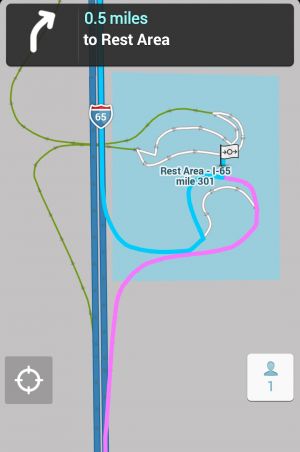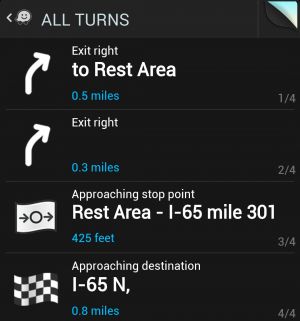Single area split access from either direction
The Cullman County Rest Area on 1-65 - mile 301 in Dodge City, Alabama has a separate lot and entrance for either direction of traffic. NOTE: This rest area has since been modified and no longer uses the configuration discussed below. It is a single area, with a single building serving both sides. However the two lots are separated and traffic is not able to cross over from one lot to other. You are not allowed to essentially make a u-turn on the fwy through the rest area.
In order for navigation to the Rest Area place to be seamless and reflect reality, we want to use only one place area, not one for each direction of travel. However in order for routing to work as expected the stop point can not be closer to either lot, or it will only be accessible from that side.
A workaround is needed
Using an unconnected segment for the stop point between both lots initially sounds like a good idea, but that causes a problem when drivers try to add the rest area "as a stop" along their existing navigation route. In order for the route not to fail there must be a valid way in and back out from the stop point.
The fix
We used a pair of two-way | | | | | Walking Trails | | | | | to form a loop connecting both parking lots. The Walking Trail segments are engineered in a specific way to only allow navigation to the stop point from either direction, and then back into the same parking lot you approached from.
- The stop is set in the middle of one of the loop segments, this will be used from either direction of travel. The segment with the stop point is connected to the PLR of both lots in a "C" shape, this allows it to be accessed from drivers coming in from either lot.
- The ends of the segment are overlapping the PLR a bit, and have a turn angle of 0° to suppress an navigation instructions being given for the actual loop itself. These instructions would be confusing to a driver, since they can't actually drive on the loop.
- The second second segment making up the loop is the exact opposite of the first one, looking like a backwards "C", and also overlapping the PLR at the ends, with 0° turn angles.
- The turn restrictions are setup to force any route back out to the parking lot it started on. This is accomplished using the premise that Waze will only route a U-turn at a junction node where the U-turn is allowed. Therefore we know that any route entering the walking trail must exist from the opposite side is entered. With the following turn restriction setup, any route into a walking trail, will be forced to the second walking trail, and then forced to continue back onto the same Parking Lot Road it started on. In short any route into the walking trail loop, will only be allowed to leave the walking trail at the same junction node.
- The Turns from both parking lots into the first walking trail segment (with the stop point on it) are allowed.
- Turns from the parking lots into the second walking trail segment are not allowed.
- The turns from the first walking trail segment out to the parking lots are not allowed, but the turns to the second trail segment are allowed. This forces anyone routed into the first trail segment to continue their route via the second the trail segment.
- Turns from the second walking trail segment back onto the first walking trail segment are not allowed, but turns back into the parking lot are allowed.
Below you can see some screenshots detailing the setup and routing.



Here is an image showing the turn restrictions, the geometry has been altered on the north side to visualize which turns are allowed.
Opposing directions of approach
This Belt Pkwy service station in Brooklyn, NY users a modified version of the above configuration. To account for the opposing directions of approach and still maintain the loop in a way that routes can only exit to the same side they entered the loop from, we twist the loop into a figure 8. The crossover is made at one end of the loop so as to keep one segment available as the target for the places stop points (especially relevant when you may have multiple point places for a tavel plaza. Be sure to add a junction node with only straight through turns allowed where the two loop segments cross (so they don't cross over each other without a junction at the same elevation).

